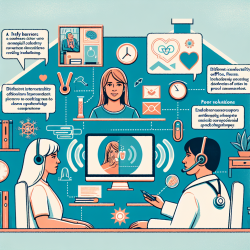Introduction
Telehealth has become an integral part of healthcare delivery, especially in the wake of the COVID-19 pandemic. However, despite its potential to revolutionize healthcare access, several barriers hinder its widespread adoption. The research article "Barriers to Video Call–Based Telehealth in Allied Health Professions and Nursing: Scoping Review and Mapping Process" provides valuable insights into these challenges. In this blog, we explore the key findings of the study and discuss strategies practitioners can employ to enhance their telehealth services.
Understanding the Barriers
The study identified eight main categories of barriers to video call-based telehealth:
- Technology Issues: These include limited access to technology, unreliable network connections, and a lack of technology skills among both healthcare providers and patients.
- Practice Issues: Challenges such as diminished fidelity of observations, lack of hands-on methods, and insufficient training and guidelines were highlighted.
- Patient Issues: Inappropriate target groups, patient behavior management, and safety concerns were significant barriers.
- Environmental Issues: Physical, sensory, and social environmental factors can limit the telehealth experience.
- Attributions: Negative attitudes towards telehealth from providers and patients, along with perceived drawbacks, affect its acceptance.
- Policy and Regulation Issues: Privacy, security, billing, and reimbursement concerns were frequently mentioned.
- Interpersonal Issues: Reduced client-practitioner interaction and communication were significant concerns.
- Administration Issues: Lack of support and increased workload were identified as barriers.
Strategies for Overcoming Barriers
Addressing these barriers requires a multifaceted approach:
- Invest in Technology: Ensure reliable network connections and provide training for both practitioners and patients to enhance technology skills.
- Develop Comprehensive Guidelines: Create detailed protocols and training programs to address practice-related issues, ensuring that practitioners are well-equipped to deliver effective telehealth services.
- Enhance Patient Selection and Support: Develop criteria for patient selection and provide additional support for those who may struggle with telehealth, such as older adults or those with limited technology access.
- Foster Positive Attitudes: Educate both practitioners and patients about the benefits of telehealth to improve acceptance and reduce resistance to change.
- Ensure Privacy and Security: Use secure platforms that comply with data protection regulations to address privacy concerns.
- Improve Communication Skills: Train practitioners to enhance their communication skills, focusing on nonverbal cues and rapport-building techniques.
- Provide Administrative Support: Offer technical and administrative support to reduce the workload and stress associated with telehealth services.
Conclusion
The study underscores the importance of addressing the barriers to video call-based telehealth to improve its adoption and effectiveness. By investing in technology, developing comprehensive guidelines, and fostering positive attitudes, practitioners can enhance their telehealth services and achieve better outcomes for their patients. As telehealth continues to evolve, ongoing research and adaptation will be crucial to overcoming these challenges and maximizing the potential of this innovative healthcare delivery model.
To read the original research paper, please follow this link: Barriers to Video Call–Based Telehealth in Allied Health Professions and Nursing: Scoping Review and Mapping Process.










